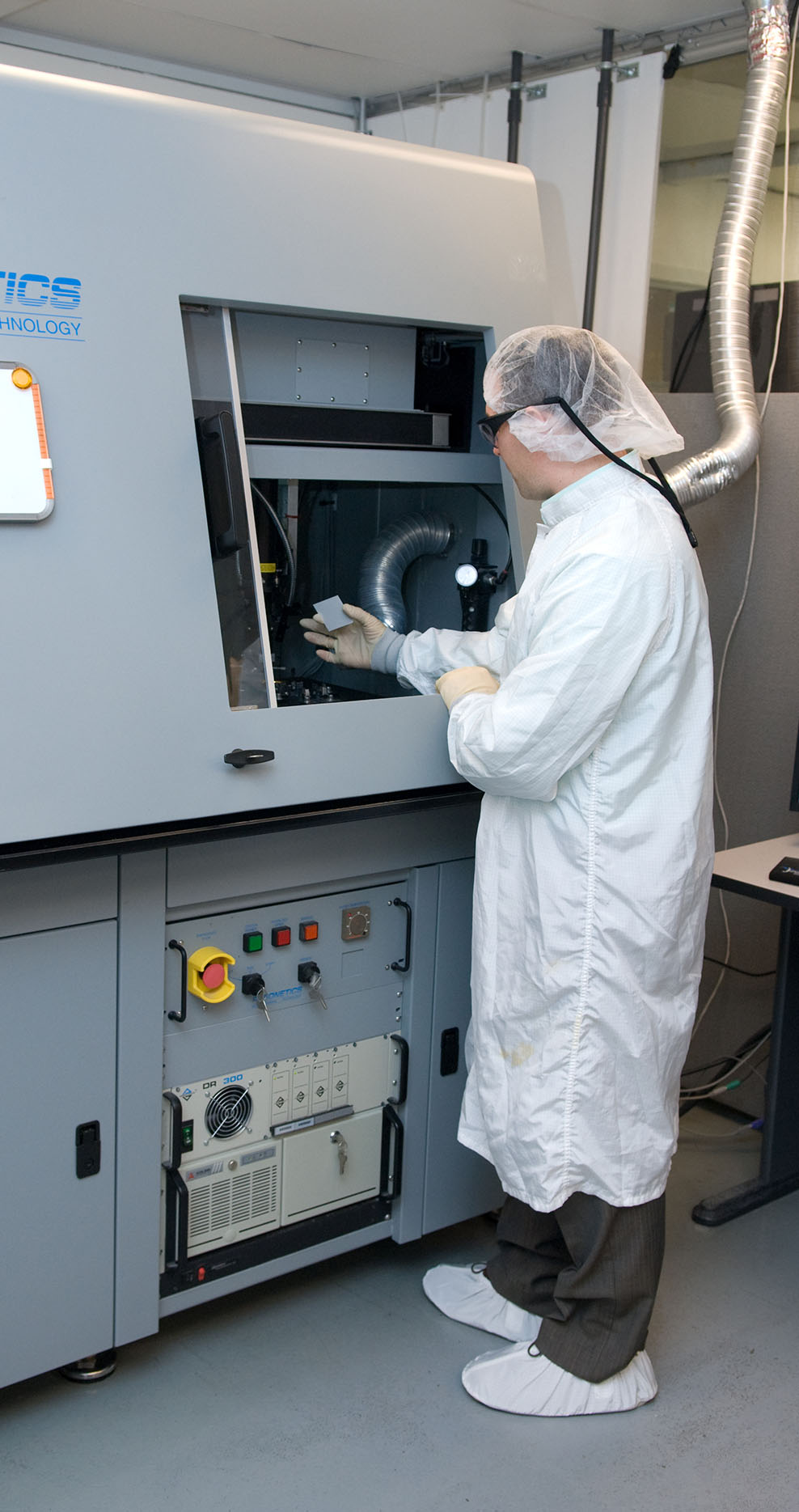Conductor / Resistor Films
A basic understanding of thin film resistor design is required if you want to integrate sheet resistors into your circuit. Thin film sheet resistors are typically fabricated by sputtering a film of Tantalum-Nitride (TaN) under the conductor layer and then selectively etching the resistor elements. TaN resistors are very stable and reliable after they are passivated at high temperatures. Nichrome (NiCr) resistors are used in specialty applications where a low TCR (Temperature Coef cient of Resistance) is required.
Commonly Used Conductor/Resistor Films
| WTi/Au | |
| Typical Applications | Devices processed at high temperatures, such as Au/Ge eutectic bonding temps |
| Advantages | Film withstands excursions to 450°C |
| Disadvantages | Barrier layer recommended for eutectics |
| Temperature Guidelines | 450°C for 30 minutes |
| Pb/Sn, Au/Sn Solderability | Possible diffusion/enrichment |
| Allowable Die Attach Methods | · Epoxies · Au/Ge eutectic · Au/Si eutectic · Au/Sn solder · Pb/In eutectic |
| Typical TCR | n/a |
| Front Side Metal | · Sputtered WTi 300-500Å · Sputtered Au 20-300µ” |
| Back Side Metal | Same as front side |
| WTi/Ni/Au | |
| Typical Applications | Devices processed at higher temperatures requiring a solderable film |
| Advantages | Film withstands brief excursions to 325°C |
| Disadvantages | Wire bonding problems may be possible due to Ni-Au diffusion when devices processed > 300°C |
| Temperature Guidelines | 300°C for 120 minutes |
| Pb/Sn, Au/Sn Solderability | Good |
| Allowable Die Attach Methods | · Pb/Sn solder · Au/Sn solder · Epoxies · Pb/In eutectic |
| Typical TCR | n/a |
| Front Side Metal | · Sputtered WTi 300-500Å · Sputtered Ni 2,000-5,000Å · Sputtered Au 20-300µ” |
| Back Side Metal | Same as front side |
| WTi/Pd/Au | |
| Typical Applications | Devices processed at higher temperatures requiring a solderable film |
| Advantages | Film withstands brief excursions to 325°C but Ni-Au diffusion problems avoided |
| Disadvantages | Pd slightly more costly than Ni |
| Temperature Guidelines | 300°C for 120 minutes |
| SAC, Au/Sn Solderability | Good |
| Allowable Die Attach Methods | · Pb/Sn solder · Au/Sn solder · SAC · Epoxies |
| Typical TCR | n/a |
| Front Side Metal | · Sputtered WTi 300-500Å · Sputtered Pd 2,000-5,000Å · Sputtered Au 20-400µ” |
| Back Side Metal | Same as front side |
| WTi/Au/Cu/Ni/Au | |
| Typical Applications | High conductivity film allowing for wire bonding and/or soldering after high temp. processing |
| Advantages | · High conductivity film · Pb/Sn & Au/Sn solderable |
| Disadvantages | Wire bonding problems may be possible due to Ni-Au diffusion when devices processed > 300°C |
| Temperature Guidelines | 300°C for 120 minutes |
| Pb/Sn, Au/Sn Solderability | Good |
| Allowable Die Attach Methods | · Pb/Sn solder · Au/Sn eutectic · Epoxies · Pb/In eutectic |
| Typical TCR | n/a |
| Front Side Metal | · Sputtered WTi 300-500Å · Sputtered Cu 40µ” · Electroplated Cu 40-2000µ” · Electroplated Ni 50-150µ” · Electroplated Au 50-250µ” |
| Back Side Metal | Same as front side |
| TaN/WTi/Au | |
| Typical Applications | Devices processed at high temperatures, such as Au/Ge eutectic bonding temps |
| Advantages | · Film withstands excursions to 450°C · Passivated TaN films offer good humidity resistance |
| Disadvantages | · Not Pb/Sn or Au/Sn Solderable · Should be fully sputtered in order to provide blister free films |
| Temperature Guidelines | Stabilize resistors at 425°C for 30.120 minutes |
| Pb/Sn, Au/Sn Solderability | Poor |
| Allowable Die Attach Methods | · Epoxies · Au/Ge eutectic · Au/Si eutectic · Au/Sn eutectic · Pb/In eutectic |
| Typical TCR | -100 ± 50 ppm/°C |
| Front Side Metal | · Sputter 10-150 Ω/sq. TaN · Sputtered WTi 300-500Å · Sputtered Au 20-300µ” |
| Back Side Metal | Same as front side without the TaN layer |
| TaN/WTi/Ni/Au | |
| Typical Applications | Devices processed at higher temperatures requiring a solderable film |
| Advantages | · Pb/Sn & Au/Sn solderable · Passivated TaN films offer good humidity resistance |
| Disadvantages | Wire bonding problems may be possible due to Ni-Au diffusion when devices processed > 300°C |
| Temperature Guidelines | Stabilize resistors at 325°C for 60 minutes |
| Pb/Sn, Au/Sn Solderability | Good |
| Allowable Die Attach Methods | · Pb/Sn solder · Au/Sn solder · Epoxies · Pb/In eutectic |
| Typical TCR | -100 ± 50 ppm/°C |
| Front Side Metal | · Sputter 10-200 Ω/sq. TaN · Sputtered WTi 300-500Å · Sputtered Ni 2,000-5,000Å · Sputtered Au 20-300µ” |
| Back Side Metal | Same as front side without the TaN layer |
| NiCr/Ni/Au | |
| Typical Applications | Designs requiring precision resistors with low TCR’s |
| Advantages | Low TCR’s (0 ± 50 ppm/°C) · Pb/Sn & Au/Sn solderable |
| Disadvantages | Wire bonding problems may be possible due to Ni-Au diffusion when devices processed > 300°C |
| Temperature Guidelines | Stabilize resistors at 325°C for 60 minutes |
| Pb/Sn, Au/Sn Solderability | Good |
| Allowable Die Attach Methods | · Pb/Sn solder · Au/Sn solder · Epoxies · Pb/In eutectic |
| Typical TCR | 0 ± 50 ppm/°C |
| Front Side Metal | · Sputter 50-200 Ω/sq. NiCr · Sputtered Ni 2,000-5,000Å · Sputtered Au 20-300µ” |
| Back Side Metal | Same as front side (NiCr for adhesion only) |



